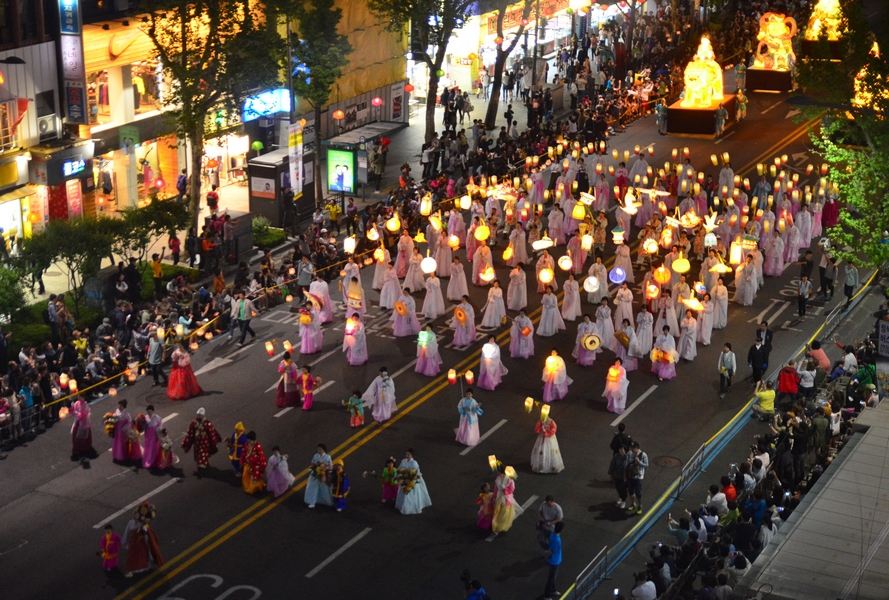[Apr] Lotus lanterns line Seoul streets for Buddha’s Birthday
Date Apr 25, 2022
 Buddhists march down Jongno during the April 2014 Lotus Lantern Parade.
Buddhists march down Jongno during the April 2014 Lotus Lantern Parade.
●Korea celebrates the world’s largest Buddhist festival.
●The UNESCO-recognized Yeondeunghoe Festival features tens of thousands of lanterns.
One day a year, rows of chairs line Jongno, the main street of downtown Seoul. People begin to claim their seats, well before police close the road to vehicle traffic. As darkness falls, the Lotus Lantern Parade – a part of Yeondeunghoe – begins, bringing festive lights to the streets.
Tens if not hundreds of thousands of people – from the most devout Buddhist monks and nuns to more casual admirers and a few lucky foreign participants – march together through the streets in what is probably the country’s biggest and most spectacular cultural festival. This year, it falls on April 30.
Starting the day before on April 29, elaborate paper lanterns go on display at various sites around the capital, including Jogyesa Temple and Cheonggyecheon Stream in downtown Seoul, as well as Bongeunsa Temple in southern Seoul. And throughout the city, smaller paper lanterns, each containing one electric bulb, light up the streets after dark. All of this is in preparation for Buddha’s Birthday, which falls on May 8 this year. Many events lead up to that day, including the lantern parade.
The holiday is known in Korean as Bucheonim Osinnal (the day when Buddha came) or Seokga Tansinil (birthday of Sakyamuni Buddha). Although most countries that practice Buddhism celebrate this day, it has become a major folk festival here. UNESCO added the Korean celebration to its Representative List of the Intangible Cultural Heritage of Humanity in 2020.
“South Korea's has by now become the biggest celebration of Buddha's Birthday in the world,” said David A. Mason, a cultural tourism professor at Sejong University. “In contemporary Seoul, this has become the biggest annual cultural festival, a gigantic event in the heart of downtown. It is one of the most globalized cultural festivals, with Buddhist guests from all over the world participating, and many languages used and translated.”
On the day of the parade, registered participants gather at Dongguk University’s main stadium for the Eoulim Madang (Buddhist cheer rally).
Then at 7 p.m., the participants start marching out, carrying a wide variety of handheld lanterns decorated with Korean letters and Buddhist symbols, as well as blossoms to simulate a crowded lotus pond. The delegations from each temple do something different, resulting in a wide variety of lanterns. Many of the bigger groups operate larger floats, some of which depict fire-breathing dragons and other mythical creatures, as well as dioramas of famous Buddhist legends and more contemporary characters like the animated busses from the Korean children’s series “Tayo.”
They march up to Dongdaemun Gate and west down Jongno, turning right at Bosingak Belfry to reach the front gate of Jogyesa, where the Hoehyang Hanmadang (post-parade celebration) is held until 10:30 p.m. All along the route, they pass by large crowds of spectators.
The following day, May 1, various cultural events and performances are offered on the blocked-off street in front of Jogyesa, concluding with a smaller lantern parade through the nearby market streets of Insa-dong.
When May 8 rolls around, Buddhist temples across the nation will welcome visitors with a range of activities, performances, food and rituals.
“Lighting the lanterns ... symbolizes enlightening the minds of individuals, communities and all of society through Buddha’s wisdom,” a UNESCO statement reads. “The festival is a time of joy during which social boundaries are temporarily erased. In times of social difficulties, it plays a particularly important role in integrating society and helping people overcome the troubles of the day.”
This 10-day celebration is an exciting time to be in Korea. Unfortunately, last year’s Lotus Lantern Parade was held mostly online, and it was canceled all together in 2020 due to the pandemic. The slogan of this year’s festival is “Back to the Life of Blossoming Hope,” signaling the celebration committee’s wishes to overcome the COVID-19 pandemic and restore daily life “where hope blooms with Buddha.”
**If you have any questions about this article, feel free to contact us at kocis@korea.kr.**

The Ministry of Culture, Sports and Tourism's "Korea Here & Now" work can be used under the condition of "Public Nuri Type 1 (Source Indication)."




